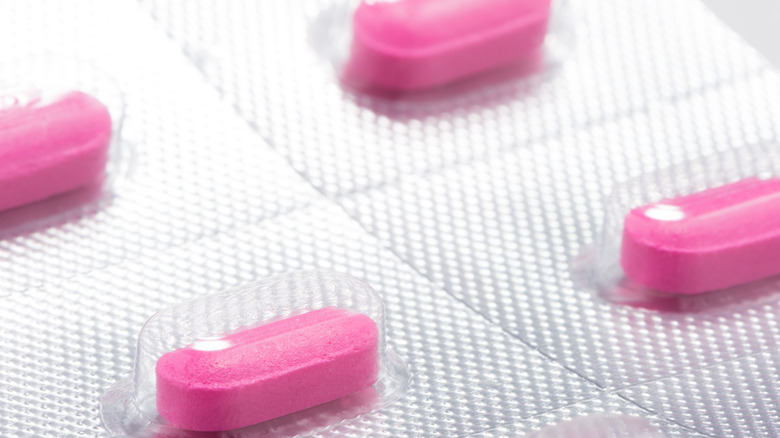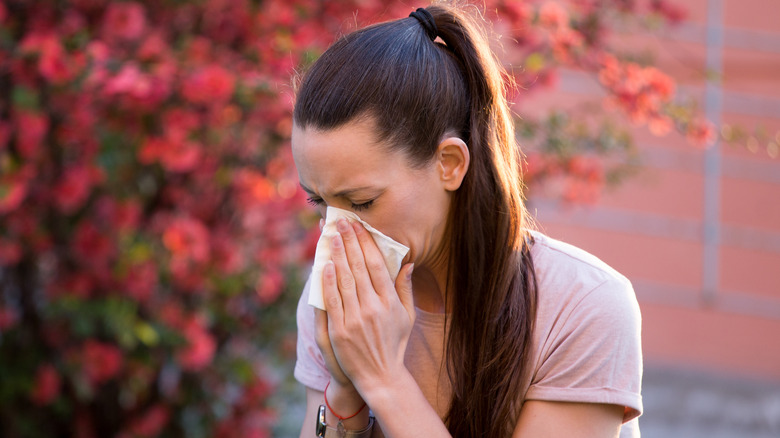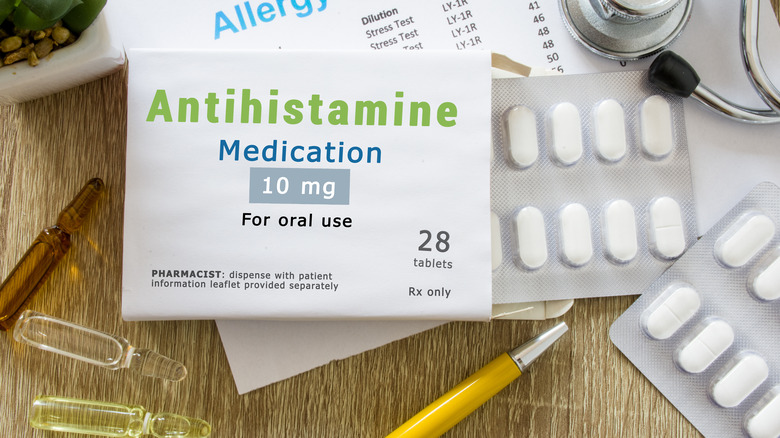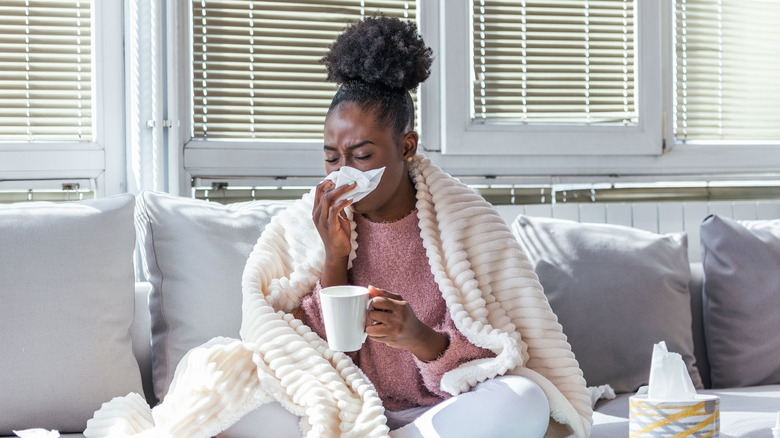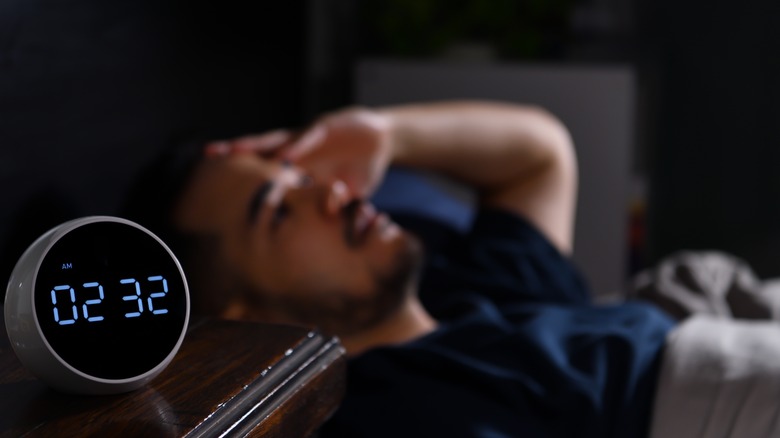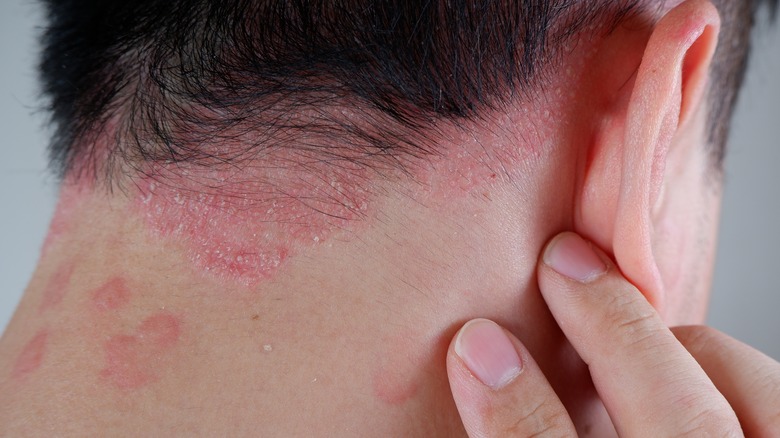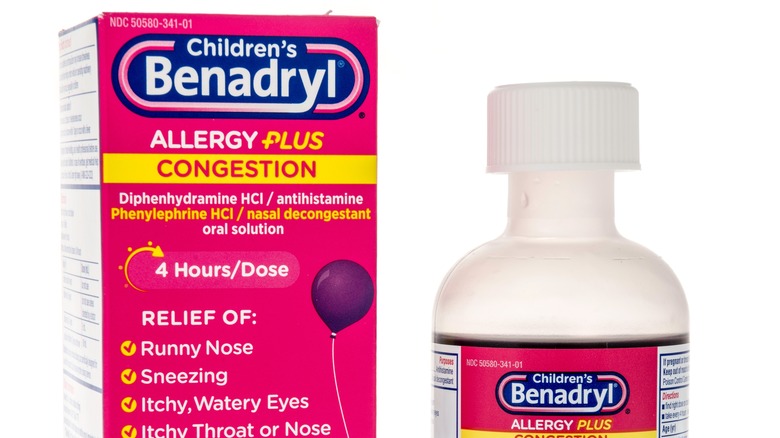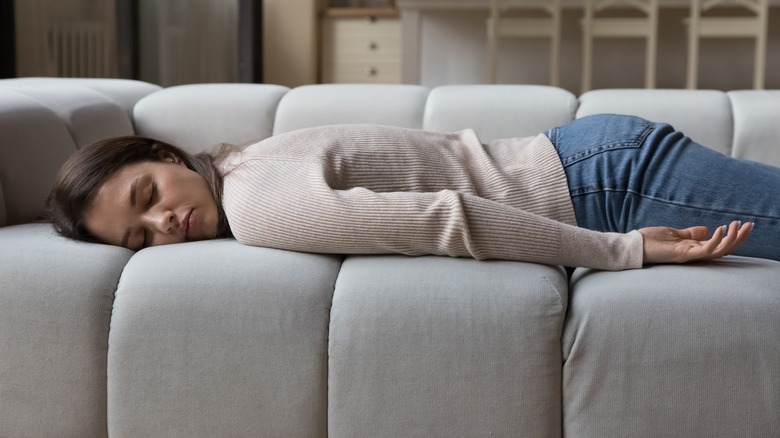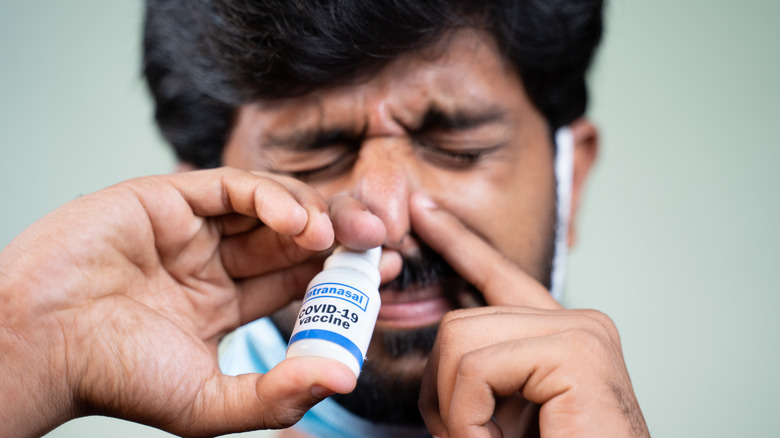Benadryl Explained: Usage, Dosage, And Side Effects
Benadryl is one of the most popular over-the-counter medications, and it seems like it has been around forever. According to the University of Cincinnati, a graduate student named George Rieveschl developed Benadryl there as part of his chemistry studies in the 1940s. This drug went on to become a trusted and frequently used allergy medication.
Benadryl is the brand name for the medication diphenhydramine (per the National Library of Medicine), a first-generation antihistamine drug. First-generation simply means that it is one of the first drugs of this class. Many people use Benadryl or its generic counterparts to treat allergies, hives, insomnia, motion sickness, and other conditions.
Benadryl comes as a capsule or tablet, chewable tablet, and as an oral solution, so even children can take it (at the age-appropriate dosage, of course). But as with any other medication, Benadryl can cause side effects, so it is best to talk to your doctor before taking it.
What are allergies?
Many people experience allergies — especially hay fever in the spring or other reactions to pollen — but might not understand the science behind them. According to the Australian Society of Clinical Immunology and Allergy, allergies occur when the body treats generally innocuous substances as threats to the immune system and mounts an unnecessary immune response. Allergic reactions can vary from person to person, ranging from a runny nose and watery eyes to life-threatening anaphylaxis.
Some of the most common allergens, or substances that trigger an allergic response, are dust mites, pollen, mold, animals, insects, and ticks. Some people develop allergies to certain foods and medications. According to the Food and Drug Administration (FDA), the most common food allergens are milk, eggs, fish, shellfish, tree nuts, peanuts, wheat, soybeans, and sesame. Federal law requires food manufacturers to label any products containing these allergens.
Medications can also trigger an allergic response. Antibiotics like penicillin, over-the-counter pain relievers such as aspirin and ibuprofen, and certain chemotherapy and autoimmune medications are the most common drug allergens (per the Mayo Clinic).
What are antihistamines?
When your body encounters an allergen like pet dander or goldenrod pollen, it can trigger an immune response and begins producing histamine. Histamine causes your blood vessels to swell and dilate, producing the uncomfortable symptoms of allergies. According to a 2018 study published in the journal Frontiers in Immunology, histamines also induce the secretion of gastric (stomach) acid, inflammation, and bronchoconstriction (tightening of the airways).
According to the Cleveland Clinic, antihistamines are a class of drug that counteracts histamine. Benadryl is a first-generation antihistamine, meaning that it is among the first approved antihistamine drugs. Like other first-generation antihistamines, Benadryl works by blocking histamine receptors in the brain and spinal cord. Histamine receptors are molecules that recognize and accept histamine molecules. Blocking these receptors prevents histamine from triggering an allergic response in those cells.
Benadryl and other first-generation antihistamines such as brompheniramine (Children's Dimetapp Cold), chlorpheniramine (Chlor-Trimeton), dexchlorpheniramine dimenhydrinate (Dramamine), and doxylamine (Vicks NyQuil) can cross the blood-brain barrier and cause sleepiness or drowsiness in some people. Second-generation antihistamines such as loratadine (Claritin), cetirizine (Zyrtec), and fexofenadine (Allegra) do not cross the blood-brain barrier and should not cause drowsiness.
Benadryl is used to treat hay fever
Hay fever is the common term for allergic rhinitis, and it is one of the most common types of allergic reactions. Many people experience hay fever, especially in the springtime when the flowers and trees are blooming, blossoming, and shedding pollen. Pollen is one of the main triggers of hay fever, along with dust mites and animal dander (per the Mayo Clinic). Animal dander is made up of tiny particles of skin that cats, dogs, and even birds shed — pet owners, beware!
According to MedlinePlus, Benadryl can relieve symptoms of hay fever such as a runny nose, sneezing, and itchy, red, watery eyes. You can take Benadryl every 4 to 6 hours. While it will reduce your symptoms by blocking the histamine produced by your body, it will not get to the source of your allergies. Your symptoms will start up again once the Benadryl wears off if you are still exposed to the allergen.
If you can, take steps to reduce your exposure to known allergens. During pollen season, keep your windows closed, and think about running an air filter indoors, especially in your bedroom. Consider wrapping your pillow and mattress in an allergen-proof cover. You may wish to see an allergist to determine the specific allergens that bother you.
Benadryl may help with the common cold
People say there is no cure for the common cold, but there is a treatment. If you are coughing, sneezing, and dealing with a sore throat caused by post-nasal drip, consider taking Benadryl. While it won't tackle the virus that is making you sick, it can provide relief from the symptoms that are making you miserable (per MedlinePlus). If you take Benadryl for cold and cough symptoms, you should take it every 4 to 6 hours.
In recent years, doctors have increased their recommendations of antihistamines for children with a cold, according to a 2019 study published in JAMA Pediatrics. Daniel Horton, assistant professor of pediatrics at Rutgers Robert Wood Johnson Medical School and lead study author, told Rutgers Today that this trend seems to be in response to the FDA's recommendation against children under age 2 taking cold medication and the American Academy of Pediatrics' recommendation against children under age 6 taking cold medication. However, the benefits of Benadryl in treating the common cold in children are unclear. If your child is sick, keep them hydrated and rested. Use over-the-counter pain medication as needed for pain and fever, and offer honey to children over 12 months for a sore throat.
Benadryl can be used to treat insomnia
Because Benadryl, like other first-generation antihistamines, crosses the blood-brain barrier, it can cause drowsiness in some people (per the Cleveland Clinic). It is no surprise, then, that many people use Benadryl off-label as an over-the-counter sleep aid. In fact, ZzzQuil, an over-the-counter sleep aid, has the same active ingredient as Benadryl, diphenhydramine (per Medical News Today).
If you need help falling asleep from time to time, take Benadryl about 20 minutes before you go to bed, according to the National Health Service (NHS). It should take effect about 30 minutes after you take it. You should not drink alcohol when you take Benadryl.
While it is probably okay to use Benadryl on occasion when you have a tough time falling asleep, it is not the best solution if you struggle with chronic insomnia. You might benefit from other strategies to help you sleep, such as a short-term prescription sleep aid, lifestyle changes, and behavior therapy (per the Mayo Clinic). Talk to your doctor if you have difficulty sleeping more than just every now and then.
Benadryl can treat certain skin disorders
Benadryl can be used to treat more than just runny noses and insomnia. It can also help with a wide variety of skin conditions. According to a 2021 study published in the journal Dermatology and Therapy, histamine blockers such as Benadryl can help with itching and urticaria, the medical term for hives — welcome relief to anyone who has every suffered through hives or an itchy rash.
Benadryl may also help patients who have acne or seborrhea. While you might think of acne as just some pimples associated with adolescence, it is actually an inflammatory disorder of the skin that occurs when sebum and dead skin block hair follicles (per the National Institute of Arthritis and Musculoskeletal and Skin Disease). Seborrhea causes an itchy, red rash and white scales, explains a 2000 article in the American Family Physician. Seborrhea of the scalp, a.k.a. dandruff, can be both uncomfortable and embarrassing. According to the study from Dermatology and Therapy, Benadryl reduces growth hormone production and sebum production, which in turn reduces acne and seborrhea.
Researchers continue to explore the use of Benadryl in treating other skin disorders. Benadryl has also been shown to alleviate the burning pain caused by the rare disorder erythromelalgia (via Dermatology and Therapy). It can also relieve the itching caused by psoriasis, as was found in a 2017 study in the Polish journal Postepy Dermatologii I Alergologii.
Benadryl can prevent and treat motion sickness
If you have ever spent part of a cruise holed up in your cabin, wishing you were back on dry land, you will be glad to know that Benadryl may help in treating and preventing motion sickness. Planes, trains, automobiles, cars, buses, roller coasters, and even virtual reality can also give people motion sickness.
According to a 2017 review from the Cochrane Database of Systematic Reviews, motion sickness occurs because of the contrast between actual motion or the illusion of motion and passive movement of the body. In other words, you feel sick because your brain sees the scenery moving by while your body stays in one place. Motion sickness can make people feel nauseated, dizzy, or like their heart is pounding. They may also vomit, sweat, or develop a headache. While motion sickness is more common in children over age 2 but under age 9, some adults continue to experience motion sickness.
According to a 2015 article in U.S. Pharmacist, you should take 25 to 50 mg of Benadryl about 30 minutes before your journey, then take as needed every 6 to 8 hours. Antihistamines like Benadryl can help with motion sickness, but they can also cause side effects like drowsiness, dizziness, and impaired cognitive function and memory (per the Cochrane Database of Systematic Reviews). It is fine to take Benadryl for motion sickness if you are the passenger, but steer clear if you are the one driving.
Benadryl can treat some symptoms of Parkinson's disease
According to the Mayo Clinic, Parkinson's disease is a progressive neurological disorder impacting the nervous system, and symptoms can manifest anywhere in the body that is conrolled by nerves. For instance, Parkinson's can cause tremors in the limbs, slowed movement, rigid muscles, altered posture, problems with balance, changes in speech and handwriting, and loss of automatic movements such as blinking and smiling.
George Rieveschl developed Benadryl in the 1940's, and by the 1950's scientists had already discovered that it could help patients with Parkinson's disease. According to a 1951 study in the journal Neurology, eight patients with Parkinson's disease showed improved symptoms while they were administered Benadryl over a period varying from 3 to 14 months. More recently, a 1999 article from the journal American Family Physician found that Benadryl helped patients with symptoms of parkinsonism and dystonia. Parkinsonism is a broad term to describes Parkinson's disease as well as other conditions that cause similar symptoms (per the Cleveland Clinic). Dystonia refers to the involuntary, sustained muscle contractions that cause people with Parkinson's disease to shuffle, move slowly, and experience tremors and rigidity (per MedlinePlus). This article notes that 25 mg of Benadryl at bedtime may be used to help relieve symptoms.
Other research suggests that Benadryl may even prevent people from developing Parkinson's disease. A 2019 study published in the journal Clinical Drug Investigation found that Benadryl use was associated with a decreased risk of developing this disorder.
How much Benadryl should you take?
As with any medication, it is important that you take the right dosage of Benadryl. How much Benadryl you should take depends on your age, condition, and the form of Benadryl you are taking (per Medical News Today).
For a runny nose caused by hay fever or a cold, adults and children 12 and older should take 25 to 50 mg of Benadryl every 4 to 6 hours. Children age 6-12 should take a smaller dose, 12.5 to 25 mg every 4 to 6 hours. No matter what, adults should not take more than 300 mg of Benadryl per day, and children should not take more than 150 mg each day. According to Diphenhydramine, adults and children age 12 and older can take 25 mg of Benadryl half an hour before bedtime for the short-term treatment of insomnia. For motion sickness, children should take 12.5 to 25 mg half an hour before departure, and adults as well as children 12 and older should take 25 to 50 mg half an hour before the event.
Over-the-counter Benadryl is not approved for children younger than age 6, but may be used under the advisement of your pediatrician.
Side effects of Benadryl
Any medication has the potential to cause adverse side effects, so you should always be on the lookout for side effects after taking Benadryl, especially if you have not taken it before. Many of the most common side effects of Benadryl are mild and should go away in a few days or whenever you stop taking this medication. Some side effects include drowsiness, dizziness, weakness, and headache. It can also cause constipation, dry mouth, nausea, vomiting, and loss of appetite. Some people become nervous after taking it, and children in particular may become overly excited (per MedlinePlus).
Benadryl can also cause more serious side effects. According to MedlinePlus, it can cause vision problems and difficult or painful urination. Medical News Today notes that it can cause impaired thinking, memory problems, confusion, dementia, rapid heartbeat, and seizures. Some people can experience a severe allergic reaction known as anaphylaxis (per Diphenhydramine). Call your doctor right away if you experience any of these or other adverse effects after taking this medication.
Some people should not take Benadryl
Not everyone should take Benadryl. As Diphenhydramine notes, anyone with a documented hypersensitivity to Benadryl should not take it again. People taking central nervous system depressants such as tranquilizers, hypnotics, and sedatives, as well as people who regularly drink alcohol, should also avoid Benadryl. Benadryl has an additive effect with these substances, meaning that it exaggerates their effect on the body.
Patients taking monoamine oxidase inhibitors (MAOIs) should not use Benadryl. According to the Mayo Clinic, MAOIs are a type of antidepressant, and they can cause serious interactions with a variety of foods and drugs, including Benadryl. MAOIs can intensify Benadryl's anticholinergic effects such as headache, impaired memory, and reduced cognitive function (per Anticholinergic Medications).
Premature babies and other infants should not take it, nor should breastfeeding people. Benadryl can decrease the flow of milk, although it does not affect the total amount of milk produced (per Healthline). The medication may also pass through the breastmilk to the child. Infants exposed to Benadryl may become excited, irritable, or drowsy. Pregnant individuals should also avoid Benadryl when possible. Although it is unlikely to cause any adverse effects on the developing baby, those who are pregnant may be more sensitive to the medication than they are normally (per Healthline). If you are pregnant or breastfeeding and suffering from allergies, talk to your doctor about how to best alleviate your symptoms.
There are alternatives to Benadryl
If you cannot take Benadryl but still need relief from symptoms of hay fever, allergies, a cold, insomnia, or motion sickness, talk to your doctor. There are many other options available that may help.
Benadryl is a first-generation antihistamine, and you may be able to use another drug in this category, such as Chlor-Trimeton (per the Cleveland Clinic). Other first-generation antihistamines also cross the blood-brain barrier and cause similar side effects, though, so you may prefer to try a second-generation antihistamine such as cetirizine or loratadine. These medications do not cross the blood-brain barrier, so they produce fewer side effects. In addition, they are longer acting (per the American Academy of Allergy, Asthma, and Immunology). If your main problem is itchy, watery eyes, you can also try corticosteroid eye drops (per the Mayo Clinic). Similarly, corticosteroid nasal sprays can relieve you of a stuffy, runny nose, and corticosteroid creams can relieve allergic skin reactions. Some creams are available over the counter, while stronger prescriptions require a prescription.
For chronic insomnia, you may try both lifestyle modifications as well as prescription medications (per a 2007 review in the journal American Family Physician). Exercise, sleep hygiene, and cognitive behavioral therapy may help, as can medications such as hypnotics and benzodiazepines. These medications can be habit-forming, so you should only use them for short-term treatment and while under a doctor's care.

